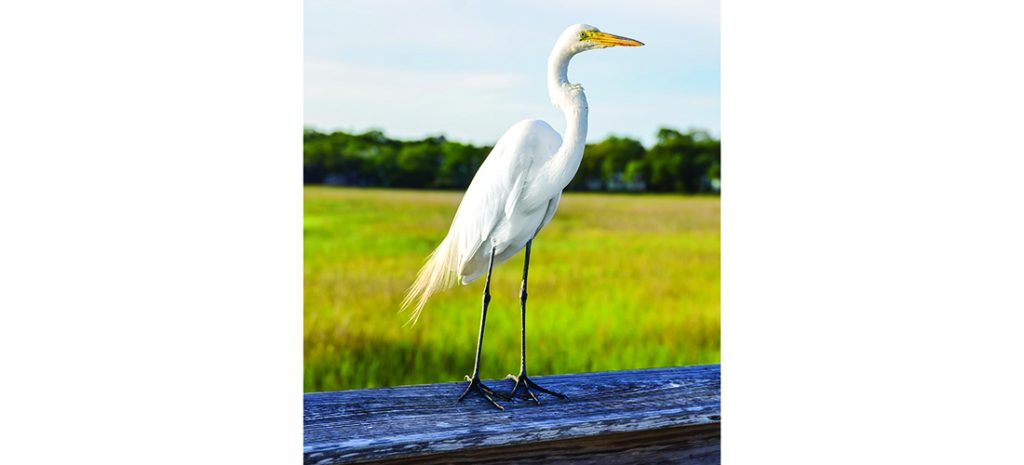BIRDWATCH

Straying Inland
The great egret pays a visit
By Susan Campbell
’Tis the season of odd sightings: Birds are wandering in all directions. After breeding and ahead of fall migration, it is not uncommon to spot out-of-place individuals here in central North Carolina. One that gets reported annually is the great egret, or mistakenly referred to as a “white crane.” This is a large wading bird with all-white plumage, a long, pointed, bright yellow bill and black legs.
Although far more likely to be found along the coast, individuals or small groups turn up on inland ponds from late July through September. Egrets stalk small fish, frogs, crayfish and other small prey in the shallows. Occasionally they will snatch a snake, small bird or large insect as well. They will roost in thick, older pines over water, where ground predators are not likely to reach them. In coastal areas, they may join dozens or even hundreds of other individuals, finding safety in numbers.
During the breeding season, from March through June, great egrets sport long plumes along their backs. At the turn of the century, the species was nearly wiped out as a result of the millinery trade. Plume hunters decimated rookeries throughout the coastal United States. But, as with most of our wading species, great egrets have made a good recovery. On the verge of extinction, they became the symbol of the National Audubon Society, the oldest and largest bird conservation organization in the United States, originally founded to protect birds from being killed for their feathers.
Great egrets are found in heronries, most often alongside great blue herons, throughout the Coastal Plain. Nesting habitat consists of sturdy trees usually on islands, free of mammalian predators. Simple stick platforms are constructed by the males and placed high in the canopy. Nests can be quite large, being up to a few feet across and a foot or so deep. One to six eggs are laid and incubated for almost four weeks by the female. The young are then fed by both parents for about a month before they are capable of flight. If there is a shortage of food, aggressive larger siblings are known to kill smaller ones. Fledglings may follow their parents for a few weeks or may become independent quickly, if food resources are scarce.
Both great egret adults and young of the year will disperse from their breeding areas to find new feeding areas. They are often seen in late summer on inland lakes, even in our mountain counties. In our area, they may use lakes, beaver ponds, creek or river floodplains, even water hazards on golf courses. They do not tend to stay in one place for very long so, should you come upon an egret this season, enjoy it because it likely will not be around more than a few hours — a day or two at most. PS
Susan Campbell would love to receive your wildlife sightings and photographs at susan@ncaves.com.
